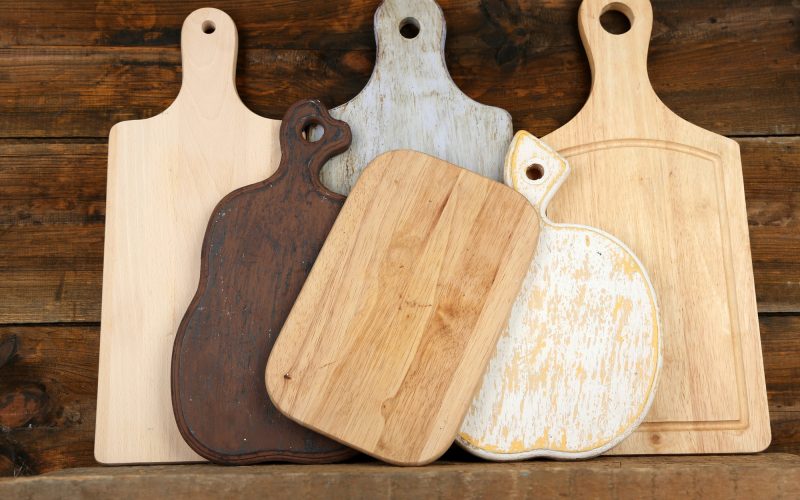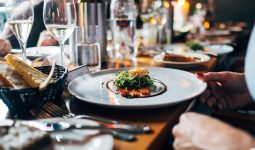Few kitchen utensils are as important as a cutting board. Whether you’re cutting vegetables meat or simply making sandwiches, a good cutting board will make your life easier in the kitchen.
Of course, if you have the manual dexterity of a surgeon, you can probably accomplish a lot with a paring knife and a suboptimal surface.
But a reliable cutting board is essential for the rest of us to simplify meal prep.
Cutting boards are essential tools in the kitchen. Cutting boards can be used for chopping, slicing, and preparing food.
There are several types of cutting boards, each with its unique features, purpose, and advantage.
The main different types of cutting boards are wood, plastic, bamboo, composite, and glass.
We also have butchers, which are a type of wooden cutting board designed specifically for meat.
Each of these boards has unique advantages and disadvantages that make them more or less ideal for different types of cooking tasks.
The choice of cutting board depends on factors like the type of food you prepare, your personal preferences, and maintenance considerations.
As you read, we’ll explore the different types of cutting boards in more detail.
By the end of this guide, you will know exactly what type of board suits your needs.
Different Types of Cutting Boards
1. Wooden Cutting Boards
Wood is naturally antimicrobial to some extent, which makes it a hygienic choice.
It’s also gentle on knife edges, reducing blade dulling. Wooden boards also add an aesthetic appeal to the kitchen.
Wooden boards require regular maintenance, including oiling, to prevent drying and cracking. Note that they are not dishwasher safe.
Wooden Cutting boards can either be made with hardwood or softwood.
- Hardwood: Common hardwoods for cutting boards include maple, oak, cherry, and walnut. They are durable and resist knife marks well.
- Softwood: Pine and cedar are examples of softwood cutting boards. They are less durable and prone to knife marks but are budget-friendly.
2. Plastic Cutting Boards
Plastic cutting boards are relatively affordable, easy to clean (dishwasher safe), and come in different colors to designate for specific food groups (e.g., red for meat, green for vegetables).
Over time, plastic boards can develop deep knife marks that harbor bacteria and may need frequent replacement. Plastic cutting boards can be made with high-density Polyethylene or Polypropylene.
High-Density Polyethylene (HDPE) is durable, non-porous, and resistant to moisture and bacteria. They come in various colors to help prevent cross-contamination. Polypropylene is also durable and dishwasher-safe. They are more rigid than HDPE boards.
3. Bamboo Cutting Boards
Bamboo is an eco-friendly and renewable resource. Thus, bamboo cutting boards can be excellent. Bamboo is also durable, resistant to moisture, and knife-friendly. They are usually aesthetically pleasing and relatively easy to maintain.
Bamboo boards, however, require regular oiling, similar to wooden boards, to prevent cracking and drying. They may not be as resistant to knife marks as some hardwoods.
4. Glass Cutting Boards
Glass cutting boards are highly durable, easy to clean, and resistant to staining. They are also less porous, making them less likely to harbor specks of dirt or bacteria.
On the other side, glass is challenging, which can quickly dull knife blades. Additionally, it can shatter at the slightest dropping.
5. Composite Cutting Boards
These boards are made from a combination of materials, such as wood fibers and resin. They aim to combine the benefits of wood and plastic.
Composite boards are durable, knife-friendly, and resistant to moisture. They require less maintenance than traditional wooden boards. However, composite boards can be more expensive than other options of cutting boards.
6. Flexible Cutting Mats
One of the different types of cutting boards includes thin, flexible cutting mats usually made of plastic or silicone. They are easy to store, dishwasher safe, and also lightweight.
They are suitable for small cutting tasks and for preserving knife blades. On the wrong side, They are not as durable as traditional cutting boards and may need frequent replacement.
7. Marble or Granite Cutting Boards
These boards are prized for their elegant appearance and natural cooling properties. They can be beneficial when working with pastry or chocolate.
They are also resistant to heat, making them suitable for hot items. Marble and granite are also tough and can quickly dull knife blades. They are cumbersome and can break if dropped.
8. Silicone Cutting Boards
Silicone boards are one of the fantastic cutting boards out there. They are lightweight, flexible, and easy to store. They are also heat-resistant and can double as trivets.
Additionally, they are dishwasher safe. They may not be as durable as other materials and can develop cut marks over time.
9. End-Grain Cutting Boards
These types of cutting boards are often considered the premium choice in wooden cutting boards. They are made by gluing together wood pieces with the grain facing up, creating a checkerboard pattern on the board’s surface.
End-grain boards are exceptionally durable, knife-friendly, and visually appealing. They show fewer knife marks. However, they are typically more expensive than wooden cutting boards and require regular maintenance.
10. Custom Cutting Boards
This type of board is for people who choose to have cutting boards custom-made to their specifications. This allows unique designs, sizes, and materials to match personal preferences.
Custom cutting boards can be tailored to your specific needs and aesthetics.
They make great gifts and can be a statement piece in one’s kitchen. Custom cutting boards can be costly and unavailable depending on your location.
11. Disposable Cutting Boards
Disposable cutting boards are one of the different types of cutting boards. They are thin, often single-use cutting boards made of paper or plastic. They are designed for easy cleanup and convenient for picnics or travel.
Disposable cutting boards are sanitary and eliminate the need for cleaning. They are also lightweight and portable. On the wrong side, they are not environmentally friendly and can be less durable than reusable cutting boards.
12. Sushi Cutting Boards
These are typically made of high-quality Japanese cypress wood called “hinoki.” These boards are explicitly used for cutting and serving sushi. Hinoki wood has natural antimicrobial properties.
Aside from the material, the boards have a pleasant aroma that can enhance the sushi’s flavor. These boards are known for their beauty and authenticity. Sushi boards require careful maintenance, including drying them properly after use to prevent mold growth.
13. Butcher Blocks
Butcher blocks are thick, heavy cutting boards usually made from hardwoods like maple, cherry, or oak. They are designed for heavy-duty cutting and chopping tasks. Butcher blocks are highly durable and can withstand heavy use in professional kitchens.
They are also versatile, making them quite popular. They can, however, be quite heavy and require regular oiling to prevent drying and cracking.
14. Teak Cutting Boards
Teak cutting boards are known for their durability, natural oils, and moisture resistance. Thus, they only rot slowly. They are often used on boats and in outdoor kitchens. Teak is a highly excellent long-term investment.
The natural oils in teak wood make it resistant to moisture. Teak cutting boards can be expensive, and their hardness may dull knife blades over time.
15. Maintenance-Free Cutting Boards
Some cutting boards are designed to be maintenance-free, meaning they don’t require special care. They are often made from composite materials. These boards are convenient and may look like wood without the maintenance.
They are dishwasher-safe and resistant to stains. While they require less maintenance, they may have a different charm or longevity than traditional wooden boards.
16. Carving Boards
Carving boards are designed specifically for slicing and serving cooked meats, roasts, turkey, and ham. They often feature grooves to catch juices and prevent spills.
Carving boards are ideal for tidying your holiday dinners and can be aesthetically pleasing for presentation. They are not meant for heavy chopping and should be used exclusively for carving to avoid damage.
17. Cheese Boards
Cheese boards, also known as cheese platters. They are designed for presenting and cutting cheese. They can be made from various materials, including wood, marble, and slate.
Cheese boards often feature a unique and artistic design, making them suitable for entertaining. One disadvantage of the chess boards is that they could be better for heavy-duty chopping or cutting tasks.
18. Tofu Cutting Boards
Tofu cutting boards are one of the typical different types of cutting boards. They are small and made from wood or plastic. They are designed for slicing and draining tofu before cooking.
These boards often feature a grid pattern that allows excess liquid to drain away, leaving firmer tofu. On the wrong side, tofu boards have a specific, limited use and thus must be more versatile in the kitchen.
19. Chopping Blocks
These boards are large, thick, and heavy-duty wooden blocks designed for heavy chopping tasks like breaking down whole poultry, butchering meat, or cracking nuts.
Chopping blocks are incredibly sturdy and can withstand the most challenging cutting tasks. They can also be heavy and take up a lot of space in the kitchen. Regular oiling and maintenance are essential for these boards’ longevity.
20. Silicone Pastry Mats
These flexible silicone mats are designed for rolling out dough and pastry. Silicone pastry mats are non-stick, easy to clean, and can withstand high temperatures, making them ideal for baking. They are, however, not suitable for chopping or cutting with sharp knives.
21. Hybrid Cutting Boards
Some cutting boards combine two or more materials to offer a balance of benefits. For example, you might find a cutting board with a bamboo surface for aesthetics and a plastic or silicone base for durability and ease of cleaning.
22. Antimicrobial Cutting Boards
Some cutting boards are treated with antimicrobial agents or have antimicrobial properties incorporated into the material. These are designed to inhibit the growth of bacteria on the surface.
23. Non-Slip Cutting Boards
Non-slip cutting boards are also among the different types of cutting boards. They often have rubberized or silicone edges or bases that prevent them from moving around on the countertop during use, enhancing safety and stability.
24. Cutting Board Mats with Icons
These types of boards help prevent cross-contamination. Some cutting board mats come with printed food icons, indicating which mat to use for specific food categories (meat, poultry, vegetables, fish, etc.).
25. Multipurpose Board
Some cutting boards are designed with additional features, such as built-in colanders, rinsing bowls, measuring guides, or even a slot for holding tablets or smartphones for following recipes.
26. DIY Cutting Boards
You can create your own cutting boards if you enjoy woodworking or crafting. Many DIY plans and tutorials are available to make unique and customized home-cutting boards.
27. Roll-Up Cutting Boards
Roll-up cutting boards are flexible and easy to store. They are suitable for small kitchens or as additional workspace when needed.
28. Magnetic Cutting Board
Magnetic cutting boards have built-in magnets that help hold your knives in place. This ensures they stay organized and accessible while you work.
29. Mezzaluna Board
Mezzaluna cutting boards are designed with a mezzaluna knife, a curved, double-handled knife used for chopping herbs and vegetables. These boards typically have a curved surface to match the mezzaluna blade.
30. Bread Cutting Board
Bread cutting boards are one of the different types of cutting boards. They often feature a removable crumb-catching tray to catch bread crumbs, making cleanup easier after slicing bread.
31. Over-the-Sink Cutting Board
Over-the-sink cutting boards are designed to fit securely over your kitchen sink. This provides additional workspace and convenience for rinsing and chopping vegetables or draining pasta.
32. Rounded or Oval-Shaped Cutting Board
These boards are great for presentation and serving. They offer a unique aesthetic compared to traditional rectangular or square cutting boards.
33. Stackable Cutting Board
Stackable cutting boards are designed to save space in the kitchen. They usually come in a set with panels of different sizes that can be nested together for compact storage.
In Summary
Here are some of the different types of cutting boards listed above, but to choose which one to go for, you need to consider various factors.
These factors include suitability of the board, budget options, thickness and weight, size, allergy, personal preference, environmental impact, maintenance, purpose, and so on.
Also, remember that while choosing the right cutting board, proper care and maintenance play a significant role in ensuring the longevity and hygiene of your cutting boards.
Regularly assess the condition of your panels and replace them when necessary to maintain food safety standards in your kitchen. Using separate cutting boards for different types of food (e.g., one for raw meat and another for fruits and vegetables) is essential to prevent cross-contamination and ensure food safety.








